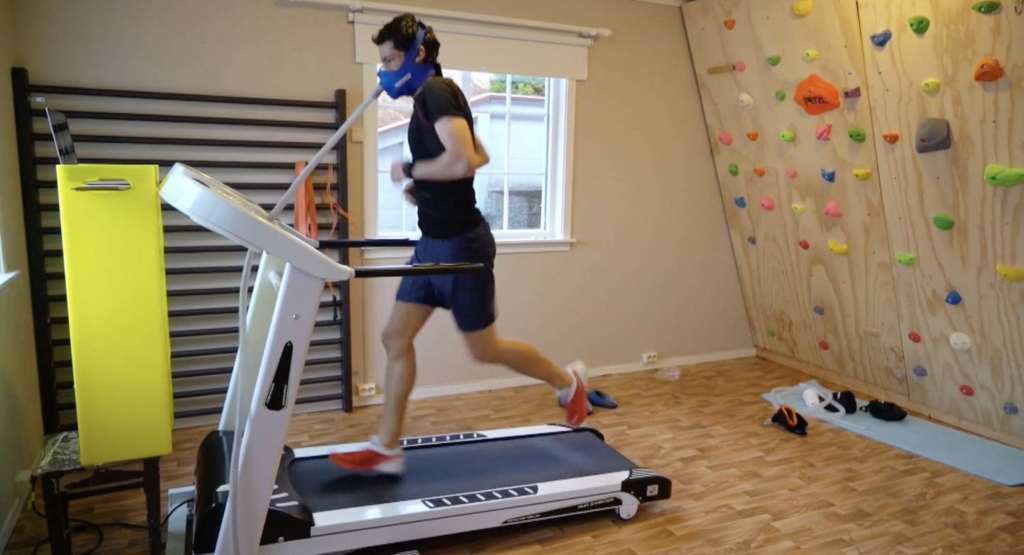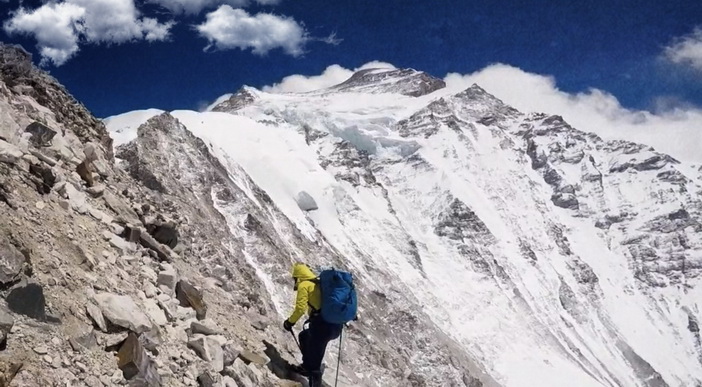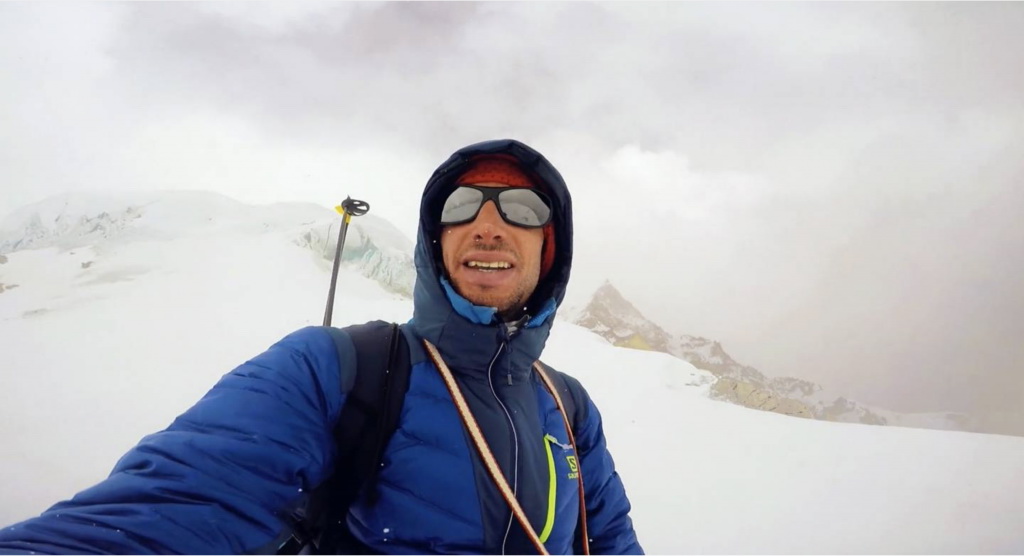-by Kilian Jornet
In spring 2017 Emelie Forsberg and I traveled to Tibet to attempt to climb Cho Oyu and Everest. I want to share how we approached our Cho Oyu and Everest preparations and acclimatization programs. Most of what I did was what many alpinists have been doing for years, and I have been trying and adjusting the last five years in the Himalaya. We placed a strong emphasis on traveling light, not spending nights sleeping above base camp, and returning to lower elevations as soon as possible. Also I used a hypoxic tent one month before departure; I believe it helps to do shorter expeditions. Climbers without a big ability to recover well from hard training will probably not have the same results with the same approach I used.
Note from Steve House and Scott Johnston
We want to applaud Kilian’s openness, it’s really cool to have him sharing this with the community.
Pre-Expedition Training for Cho Oyu and Everest
First of all I want to explain how important it is to have a high physical capacity to do this acclimatization and strategy to climb a mountain. This strategy is for athletes who have the capacity to climb easy 2,000 or 3,000 meters in altitude and have been following a training routine during years. If not, this can be more dangerous than helpful. When we were doing this pre-acclimatization, Emelie and I have been training for years on high intensity, being able to complete run or ski tours of 100 miles or more than 30 hours without stopping, to do several 25-plus-hour weeks of hard training, etc. It is important to understand that the body should be adapted to the routine of training hard and recovering fast to accept this acclimatization and strategy. I think a minimum yearly training of 700 hours to 1,200 hours is needed to consider good fitness for that.

Hypoxic Sleeping and Training Phase
Thirty days before leaving to Himalaya we began sleeping in a hypoxia tent: week 1 starting at 4,000-meter altitude equivalent and by week 4 to 5,800 meters. During those weeks we were also training in simulated altitude:
- Morning: long training outside (2 to 15 hours per day ski mountaineering and alpinism)
- Afternoon, 6 days/week: 40 minutes to 1 hour at 6,000 meters treadmill—10-minute warm-up (10 km/h) then intervals of 5 minutes slow (10 km/h flat), 5 minutes fast (12–15 km/h) OR 10 km/h at 15 percent incline.
The last week I also did this with a 6-kilogram backpack. Emelie was not doing intensity but focused on constant running up to 10 kilometers/hour. After that we were going to the Alps, sleeping at real altitudes at Plateau Rosa (3,500 meters) and training around 4,000 meters (completed the Mezzalama Race). Total of +/-300 hours at altitude (240 hours in tent home + 60 hours in the Alps). Simulated altitude (hypoxic tent, mask) was working well, but only because we spend this amount of hours in “altitude” and the protocols in the workouts. I think it can be similar result sleeping and training this protocol at real altitude naturally (Alps, Colorado, Himalayas) with normal comforts for sleeping and eating well.
Note from Steve House and Scott Johnston
We want to emphasize what Kilian says here. The fitness has to come first. If you are fit enough to handle a training load well in excess of 700 hours per year, then the hypoxic tent and hypoxic training may help add a few percentage points to your speed up high. Keep in mind that a best-in-class athlete such as Kilian has to find new training stimuli. He can’t simply add more hours of base training because he’s already at 1,200 hours per year for the past seven years. So for him, doing hypoxic training may have been beneficial. Unless you’re close to Kilian’s level, you’re probably better off putting in more training volume.
Travel
Short travel time was very important. We arranged our logistics to do a fast travel, spending only three days from Europe to Cho Oyu Base Camp (1: GNV–KTM; 2: KTM–Lhasa–Shigatse; 3: Shigatse–CBC). We traveled with only one bag with technical gear and clothes. I believe that in this way there is less loss of acclimatization and not so much fatigue as a result of long travels and spending days in cities.
On the Mountain
Once we got to the mountains were many key points that came together. Here are the most important:
- ·We always slept as low as possible (maximum ABC: 6,400 meters)
- On the mountain for the first 10 days and all the days except the actual ascents we were moving at a really low speed (max 130 bpm, speed you can talk) to not fatigue the cardiovascular system.
- We try to keep to a schedule of one rest day for one day of activity.
- Absolute maximum of two days of resting following a day of activity.
- Climb at a slow pace the first two weeks—max 130 bpm, “you can talk” pace.
- Always climb light and high and always all the way back down on the same day.
Cho Oyu and Everest: Profile of Acclimatization and Climbing
In total we stayed only 29 days in the mountains: 11 days on Cho Oyu and 18 days on Everest.

During that time I was four times over 8,000 meters:
- 8,200 meters (day 9, Cho Oyu)
- 8,500 meters (day 18, Everest shoulder)
- 8,850 meters (day 24, Everest): I spend 20 hours over 8,000 meters, 10 of those hours over 8,400 meters; I took with me 2 liters of water and 2 gels to eat.
- 8,850 meters (day 28, Everest): I spend 18 hours over 8,000 meters, 8 of those hours over 8,400 meters); 1 liter of water and 5 gels.

Recovery Post-Expedition and Return to Racing
We did travel back from last summit of Everest very quickly, as quickly as possible to minimize the de-training effect of being at high altitude and away from regular, structured training for as long as possible.
- 5/28 – From summit down to ABC, a short rest, and then that same afternoon down to CBC
- 5/29 – 6 a.m. we began to drive from CBC to Lhasa
- 5/30 – Flight leaving Lhasa
- 5/31 – Arrival Norway, evening 30-minute recovery run
- 6/1 – Start normal training. Feeling normal (as normal as possible after long travel, legs swollen), and from there a normal training week (25 hours, 15,000 meters) feeling as usual
- 6/10 – Raced a half marathon and performed well.
I believe that shorter expeditions have much less impact on post-expedition performances. I think that this is because during the expedition there is not much “rest” time. It is also important not to sleep high and to do regular activity during the expedition. These last two points are key to making the recovery much faster. I also think that to arrive to the expedition in great shape means that when you climb the mountain you don’t spend much energy. I was certainly feeling tired on the mountain due to the effort and altitude, but I felt completely recovered the following day back at the Base Camp. All of this means that the expedition does not have a bigger impact on the body than a normal month of training or racing.
Cho Oyu, a Detailed Timeline
Day 1: CBC–ABC
Day 2: Rest ABC
Day 3: ABC–6,400 meters–ABC
Day 4: Rest ABC
Day 5: ABC–6,400 meters and put a tent there
Day 6: 6,400 meters–7,500 meters–ABC. We climb up to 7,500 meters; we were feeling good, going up at a speed of 250 meters/hour, but we needed to turn around because weather deterioration.
Days 7–8: Rest at ABC waiting for good weather
Day 9: ABC–6,400 meters
Day 10: We attacked the summit from Camp 1. We left at midnight with very strong winds. During the night it was very cold and we were concerned about our feet and hands getting frostbite. At 7,200 meters we entered a crevasse to protect us from the wind and to wait for the sun to warm everything up. When the sun was up we continued at a good pace and at 11 a.m., at 7,700 meters just under the yellow band, Emelie decided to turn around. The bad weather was coming fast and there was no fixed rope on the mountain. (There were only eight climbers on the mountain this spring, so the expedition teams were late fixing ropes; they were fixing between 1 to 2 on this day.) So I was a bit uncertain if I could go down the route safely alone.
I continued to summit area in bad weather. I was feeling good up to 7,800 meters, but after that it was really hard up to 8,200 meters. I think that going to 8,000 meters in less than two weeks is possible but the last 200 meters are very, very hard. I reached the summit (or surroundings, because I was in a big snowfall and fog) and turned around and went down fast. Three hours later I was at Camp 1 where Emelie had taken down our tent. I took the rest of the gear and started down to ABC.
Day 11: ABC–CBC, drive to Tingri
Everest, a Detailed Timeline
Day 12: Travel Tingri–Everest Base Camp. Emelie returned home and I changed the valley to Everest where Seb Montaz had just arrived. Our expedition logistics were pretty simple, what also made them very economical. We paid our climbing permit to CTMA (China Tibet Mountain Association) what included our transportation in Tibet. We contracted our Base Camp services with a Nepali company. That allowed us to have one tent in the Base Camp and one in ABC and a cook and cook tent in ABC or EBC. The cost for that is between $10,000 and $15,000 depending on the summit and travels, all costs included (travel, permit, Base Camp services). It is certainly expensive, but much more accessible than normal expeditions.
Days 13–14 (1–2): Rest at Everest Base Camp
Day 15 (3): Seb and I climbed to ABC.
Day 16 (4): I climbed from ABC to 7,600 meters, 4 hours up and down.
Day 17 (5): Rest at ABC
Day 18 (6): I climbed to 8,400 meters, I was feeling very strong. I climbed from ABC at 6,400 meters to 8,400 meters in 6 hours and back in 9:30 total time. I think that was my strongest moment in the balance between acclimatization and fatigue (the moment where acclimatization is good and the fatigue is not too much). It was the 18th day since I had arrived in Tibet.
Day 19 (7): Rest at ABC.
Day 20 (8): We went down to Base Camp at 5,000 meters to rest.
Days 21–22 (9–10): Rest at Base Camp
Days 23–24 (11–12): Rest at Base Camp and at 10 p.m. in the evening I started running from Base Camp toward ABC, where I took 2 hours of rest, took all my climbing gear. In my backpack I had a headlamp, a down suit, down mittens, buff and hat, silk gloves, one ice axe, poles, the climbing overboots with crampons, sun cream, 10 gels, 2 liters of water, and one GoPro. I start climb via NNE to Everest. It took me 26 hours to summit, at midnight. I had gastric problems starting at 7,600 meters and I needed to stop a lot along the way, but it was very interesting to see that it is possible to climb a high summit starting very low (almost 4,000 meters lower) and with not any assistance or gear deposits in the mountain. And for me it was a relief to see that it was possible for me to climb it without supplemental oxygen. When I was down from the summit my feelings were divided. On one hand I was happy to climb Everest, on the other I was a bit frustrated to be sick and not being able to climb normally.
Day 25 (13): We went to Base Camp.
Day 26 (14): Rest day at Base Camp
Day 27 (15): Up again to ABC
Day 28 (16): Rest at ABC
Day 29 (17): I started climbing at 4 a.m. I wanted to feel good this time with no more gastric problems. During the days before we we took a lot more care about hygiene in the camp. The day was very windy and snowy and so it was not really possible to go fast. This time it took me 17 hours from ABC to summit. I was not as fast as I would have liked, but it was great to be in the summit again. Knowing that is possible to be this altitude this often and to be able to move “quick” for long time in big mountains was a satisfying lesson. I think the recovery time between the two ascents of Everest was a bit too short for me to be fresh. But maybe with three or four good rest days it would be enough for me to be at 100 percent again.
On the way down from the summit at around 8,300 meters I have a black hole in my memory for around 30 minutes. I don’t know why, but I left the ridge and my next memory is downclimbing a steep rocky wall. I was not very clear in my mind (I was having small hallucinations but I knew they were hallucinations) but I had a hard time knowing if what I was experiencing was a dream or real. After some more technical sections I realized that I didn’t know where I was (1 hour after leaving the normal route) and I decided to wait for some light to see where I was. I slept there for 1 hour and then I started thinking clearly again. Looking at my GPS I realized I was in the middle of the north face, close to Norton Couloir, so I traversed and downclimbed to arrive at the Messner crossing to get to the normal route and I continued down to arrive in ABC on the morning of the 28th.
Day 30 (18): When I arrived at ABC from the mountain I took a few hours of rest and then on the same afternoon we hiked down to Base Camp.
Day 31 (19): We drove to Lhasa and flew home.
Watch Kilian Jornet and Emelie Forsberg’s Video about Cho Oyu:
Learn more about Kilian Jornet’s Everest adventure.

